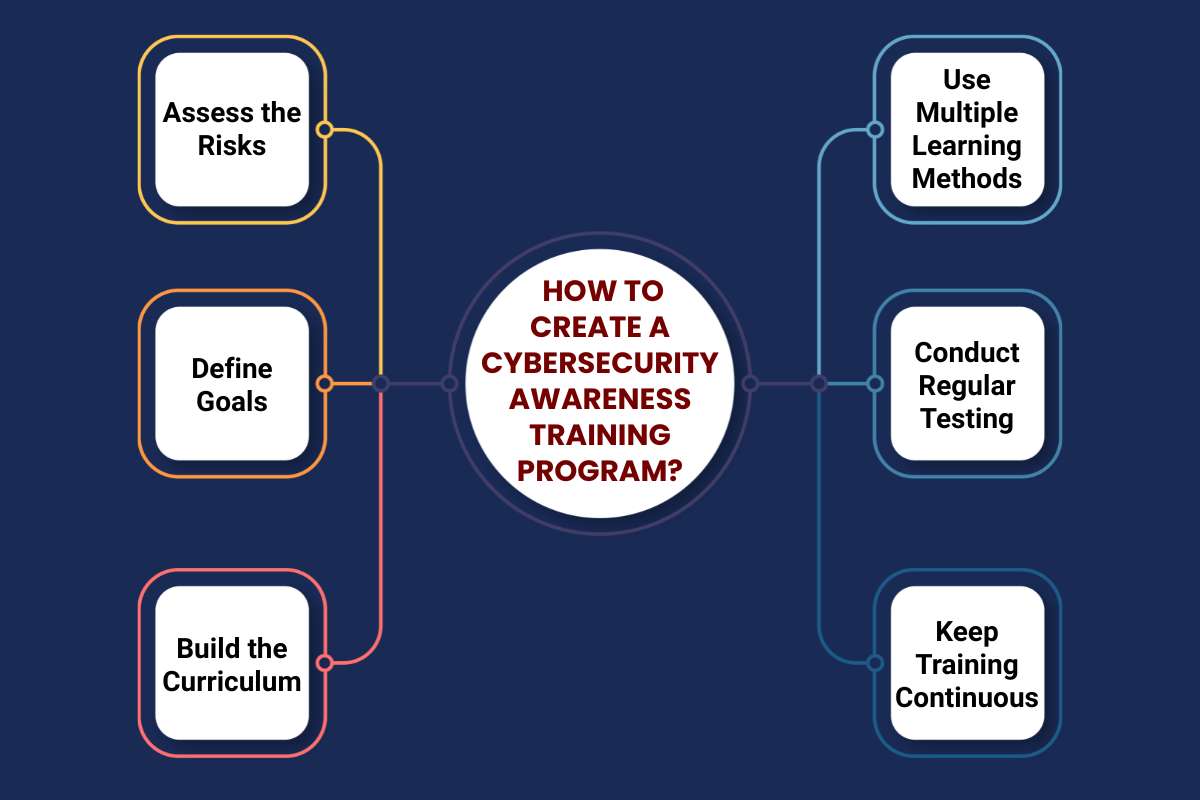“Cybersecurity isn’t just about technology; it’s also about processes, people, and governance.”
Tonya Ugoretz
Are you confident that your team knows how to spot a cyberattack? Due to the constantly rising cyber threats, one wrong click can put an entire organization at risk. Cyber attacks are growing more sophisticated every day, and understanding the basics of cybersecurity is no longer optional.
Cybersecurity Awareness Training is designed to educate employees about online threats, phishing scams, malware, and safe online practices. By learning how to identify risks and respond correctly, organizations can protect sensitive data, reduce security breaches, and build a culture of digital responsibility. This Cybersecurity Awareness Training not only strengthens your company’s defenses but also empowers employees to make smarter decisions online.
Why Cybersecurity Awareness Training Matters?
Cyberattacks are increasing every year. A 2025 IBM report indicates that the average cost of a data breach worldwide is $4.4 million. Small businesses and schools face risks just like large companies. Most attacks occur due to human errors. Employees may click phishing links, reuse weak passwords, or share sensitive data without realizing it.
Cybersecurity Awareness Training reduces these mistakes. It teaches employees to identify threats, create strong passwords, and handle data safely. Programs often cover:
- Phishing Attacks: Employees learn to identify fake emails and links.
- Ransomware: Lessons explain how to avoid infected files or risky websites.
- Password Safety: Cybersecurity Awareness Training shows how to create strong, unique passwords for each account.
- Social Engineering: Employees learn how hackers trick people into sharing information.
- Data Protection: Guidance on managing company and customer data safely.
8 Effective Tools and Platforms for Cybersecurity Awareness Training
Modern training uses interactive tools instead of long lectures. These platforms make learning fun and track employee progress. Many tools also simulate attacks so employees can practice safely.
1. KnowBe4
Key Feature: Phishing simulations with real-world scenarios.
KnowBe4 is one of the most popular tools for cybersecurity awareness training. It offers phishing simulations that mimic real attacks, helping employees recognize and report them. The platform also includes short video lessons, quizzes, and games to make learning fun and interactive.
Managers can track performance, assign lessons, and view reports to find who needs extra guidance. The gamified learning system encourages friendly competition and rewards progress, boosting engagement across teams.
2. Cofense PhishMe
Key Feature: Realistic phishing attack simulations.
Cofense PhishMe trains employees to recognize phishing attempts through realistic simulations. It sends safe, fake attacks to employees and records how they respond. This gives managers real data on their team’s readiness.
The tool’s analytics dashboard shows who clicked on fake links or opened suspicious attachments. Managers can then assign follow-up lessons for improvement. Cofense also connects with email systems, helping monitor and strengthen awareness in real time.
3. Infosec IQ

Key Feature: Gamified learning modules and awareness campaigns.
Infosec IQ mixes learning and fun through interactive courses and campaigns. It includes videos, infographics, games, and quizzes to help employees remember lessons. The platform supports over 2,000 training modules, allowing organizations to customize content for each department. It also creates compliance reports to track progress. Infosec IQ’s gamified approach keeps learners active and engaged.
4. Cyber Risk Aware
Key Feature: Real-time feedback and behavior tracking.
Cyber Risk Aware teaches through real-life risks. It sends simulated attacks like phishing emails or fake links to test reactions. When users make a mistake, they get instant feedback on what went wrong and how to fix it. The platform also includes short modules on topics like password safety and data handling. Automatic reminders keep employees learning after training sessions.
5. Proofpoint Security Awareness Training
Key Feature: Behavior-based learning with analytics tracking.
Proofpoint goes beyond facts to shape safer habits. It uses videos, tests, and phishing simulations to help employees make smart daily decisions. Its analytics track risky behavior patterns and assign customized lessons. Modules are short and engaging, fitting well into work schedules. Proofpoint also offers multilingual content for global teams, ensuring consistent learning everywhere.
6. Wombat Security Technologies (Proofpoint)

Key Feature: Scenario-based learning for real-world problem solving.
Wombat, now part of Proofpoint, uses realistic scenarios to teach users how to respond to threats. Employees practice spotting and reacting to security risks in simulated environments. It includes phishing tests, quizzes, and reports showing improvement over time. Wombat’s flexibility makes it suitable for both small teams and large enterprises.
7. Barracuda PhishLine
Key Feature: Customizable phishing simulations with deep analytics.
Barracuda PhishLine helps organizations train staff using realistic phishing simulations. Managers can create email templates that mirror real threats in their industry. The platform measures how employees react and gives detailed performance reports. It also provides follow-up lessons so users can learn from mistakes. With strong customization and analytics, PhishLine suits companies needing detailed control.
8. Learning Management Systems (LMS)
Key Feature: Customizable cybersecurity awareness training programs.
LMS platforms like Moodle, TalentLMS, and Cornerstone give organizations full control over their training. Teams can create and manage custom courses, assign lessons, and track progress. LMS systems support videos, PDFs, and quizzes, offering flexible learning options. Large companies benefit most, as these systems connect with HR tools and support multilingual training for global teams.
10 Smart Tips for Choosing the Right Cybersecurity Training Tools

- Pick a platform that matches your team size and learning goals.
- Small teams can use ready-made modules for quick setup and easy tracking.
- Larger organizations should look for customizable tools with analytics and progress reports.
- Make sure the platform is mobile-friendly so employees can learn anytime, anywhere.
- Choose tools with interactive features like games, videos, and quizzes to keep training engaging.
- Check if the platform supports multiple languages for global teams.
- Select software that integrates easily with your company’s existing systems.
- Look for regular content updates to stay aligned with the latest cyber threats.
- Always try a free demo or trial before making the final decision.
- Choose a platform that offers reporting and feedback tools so managers can track progress and guide improvement.
How to Create a Cybersecurity Awareness Training Program?

A strong Cybersecurity Awareness Training program builds habits, not just knowledge. Here’s how to create one:
1. Assess the Risks
Identify threats specific to your organization. Finance companies may worry about phishing; hospitals focus on protecting patient data.
2. Define Goals
Set clear goals, like “reduce phishing click rates by 50% in six months.” Goals help track progress.
3. Build the Curriculum
Include basic and advanced topics for cybersecurity awareness training:
- Password hygiene and authentication
- Phishing and email safety
- Safe web browsing
- Data protection and privacy rules
- Mobile and remote work security
4. Use Multiple Learning Methods
Combine short videos, quizzes, games, and real-life examples. Interactive lessons help employees retain knowledge better than lectures alone.
5. Conduct Regular Testing
Run mock phishing campaigns and review results. Provide feedback to employees to help them improve.
6. Keep Training Continuous
Cyber threats evolve fast. Schedule refresher sessions every few months to keep skills up-to-date.
Tips for Implementation:
- Keep lessons short and simple.
- Reward good performance.
- Encourage reporting of suspicious emails.
- Involve leadership to set an example for employees.
The Future of Cybersecurity Development
By 2028, 40% of large enterprises will deploy AI to monitor and influence employee moods and behaviors, fundamentally changing organizational management and culture. This shows that Cybersecurity awareness training is shifting toward AI-driven learning and personalization.
AI can adjust training based on individual users. For example, employees who click phishing links frequently can be assigned lessons focused on email safety automatically.
Virtual reality (VR) and simulations are also becoming popular. VR allows users to experience cyberattacks safely in a controlled environment. This hands-on method improves learning and prepares employees for real threats.
Cybersecurity education is expanding beyond workplaces. Schools and universities are introducing cyber hygiene courses for students. As online learning grows, children will learn to protect themselves on digital platforms.
Global collaboration is increasing as well. Governments and companies share threat data to strengthen defenses worldwide. Organizations that invest in ongoing cybersecurity awareness training can reduce breaches and cyber threats. Human awareness remains a key part of defense, even with advanced technologies.
Conclusion:
Cybersecurity awareness training is essential for everyone, not just IT teams. People who understand digital risks make smarter choices online and protect sensitive information.
With the right tools, clear plans, and continuous learning, organizations can create safer digital environments. The future of cybersecurity depends on informed, alert, and prepared users.
FAQs
1. Can Cybersecurity Awareness Training prevent all cyberattacks?
A. While it cannot guarantee complete protection, it significantly reduces risks by teaching employees to recognize threats and respond appropriately, making the organization less vulnerable to attacks.
2. Is the training suitable for individuals outside organizations?
A. Yes, anyone can benefit from Cybersecurity Awareness Training to protect personal data, understand cyber risks, and practice safe online behavior.
3. How can the effectiveness of Cybersecurity Awareness Training be measured?
A. Effectiveness can be measured through simulated phishing tests, quizzes, monitoring reported incidents, and tracking improvement in employees’ security practices over time.






